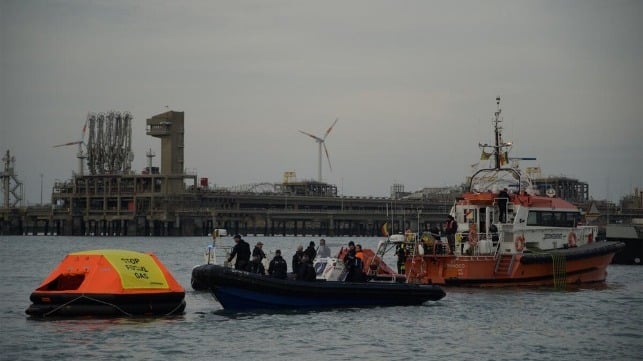Belgium Police End Greenpeace Blockage of LNG Terminal After 29 Hours

The Belgian police ended the blockade by Greenpeace protestors of the Zeebrugge LNG terminal. The group confirmed its activists have been removed and arrested after 29 hours while its sailboat was moved to a dock in the port, and the flow of LNG carriers has resumed.
As many as 70 Greenpeace activists took to the harbor on Wednesday, October 1, in a flotilla of small boats, kayaks, and inflatables surrounding the Greenpeace sailing vessel Witness (74 feet/22.5 meters). Reports said they had timed the protest and hidden at various points around the port, so that it began just after an LNG carrier departed the terminal operated by Fluxys.
The group included a large inflatable with images of Vladimir Putin and Donald Trump and a large banner reading “They love gas, you pay the price.” It was timed to the ongoing talks regarding the EU’s 19th sanction package against Russia, which calls for an end to Russian gas imports. Greenpeace, however, is also calling for an end to U.S. LNG imports, saying Europe must halt all supply contracts for fossil gas with a phase-out by 2035.
“By ending this action, law enforcement is allowing major polluting industries to continue business as usual. It’s fossil fuel companies, and their supporters, who should be held to account. But we won’t give up,” said Lisa Göldner, Fossil Fuel Campaigner, Greenpeace Germany.
A police boat was standing by near the protest on Wednesday, but initially took no action. After about 24 hours, Greenpeace said more than 40 protestors were still blocking the terminal, including with their kayaks and inflatable boats. They were determined to stay despite cold temperatures, humidity, and lack of sleep. The Witness was positioned in the inner harbor, blocking the entry to the terminal.
The LNG carrier Arctic Voyager (75,485 dwt) operated by K Line was inbound from Norway and deferred its arrival till Friday, October 3. Knutsen OAS Shipping’s vessel Rias Baixas Knutsen (96,354 dwt) was also reporting that it was drifting off Spain. Reuters, also citing LSEG data, reported that the Megara (95,452 dwt), coming from the U.S. operating for Shell’s STASCO, and MOL’s LNG carrier LNG Phecada (91,712 dwt) coming from Russia were also delaying their trips. MOL’s vessel is now due in Zeebrugge on October 5, while the STASCO vessel’s last AIS signal showed it mid-Atlantic waiting for orders.
Fluxys’ terminal is one of the largest in Europe and serves both imports and for transshipment of LNG. The company told Reuters that it was operating normally, although vessel traffic was disrupted. They were expecting the blockade to last possibly till Sunday, October 5.
The police and military undertook the effort to clear the blockade. Greenpeace said it took several hours to dismantle the blockade and that the protestors had been arrested.
